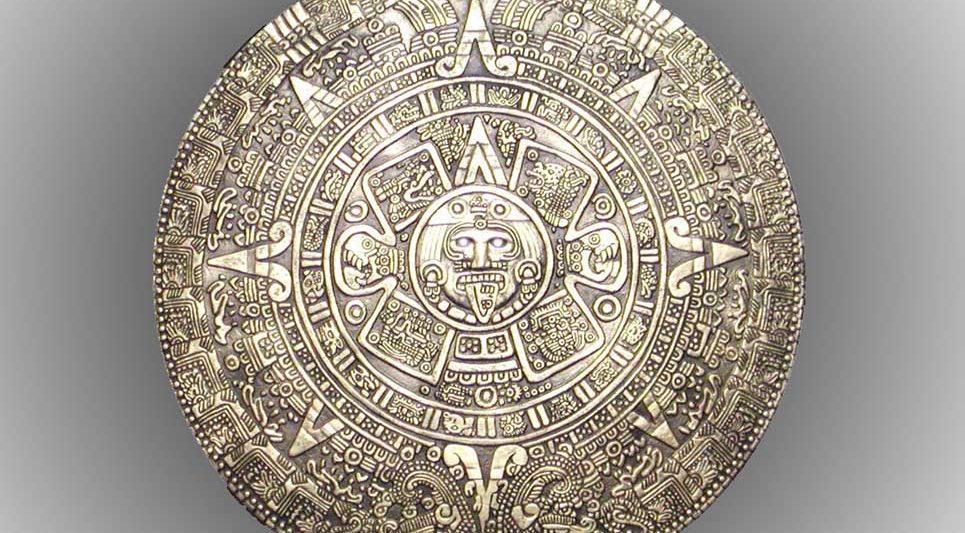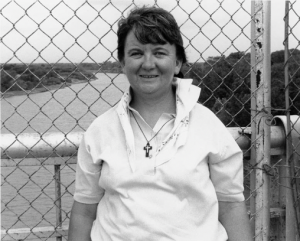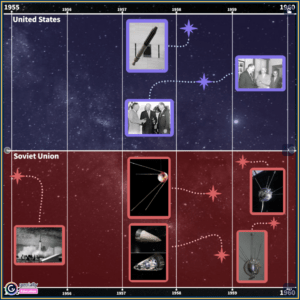Today, when most people think of the Ancient Maya, the first connection that is often made is to their intricate calendar system. What most do not know about the Mayan calendar, however, is that there are three of them. These calendars are the secular or political astronomical calendar, the religious or ceremonial calendar, and the long calendar. The secular astronomical calendar, the Haab, is the Mayan calendar most nearly aligned with our modern conventions (the Gregorian Calendar), since it is based upon a cycle of 365 earth days, while the religious calendar, the Tzolk’in, is 260 earth days; and lastly, there is the long count calendar, which cycles every 5,124 cycles of the Haab.1
Like our modern calendar, the secular, or the Haab, calendar is split into three units of measure. The first and smallest measure on the calendar is the k’in, or the day; next is the winal, which closely aligns with the modern conception of months; finally, there is the Haab, or the entire collective calendar year. There are 20 k’in in the winal, and 18 winal in the haab. There are only five days in the 19th winal, constructing a year nearly equivalent to our modernized Gregorian calendar of 365 days. However, the Mayan Haab did not contain the modern convention of weeks or leap years; each of the twenty k’in (days) in the winal (month) had individual names assigned to them.2
While the Mayan Haab calendar was quite accurate to the duration of one earth year, the methods by which the year was calculated were actually quite primitive. By observation, ancient observers of the sky would mark the positions of heavenly bodies with two staves stuck into the ground. The observers were then able to mark and measure the cycles by the time the measured star or planet took to return to its origin. Gradually, over time, temples were built around these staves, forming what appear to be permanent observatories for certain heavenly bodies. For example, at Tikal, one may stand at the top of the Lost World Pyramid and observe the alignment of three seasons with the points of three pyramids in the course of one year.3

The religious calendar, the Tzolk’in, is a cycle that runs independent of the Haab and Long Count calendars. The Tzolk’in consists of thirteen numbered days interlocked with twenty named days that bear the names of Mayan gods.4 In other words, there are no constructions of weeks, or months in the Tzolk’in; since twenty is not evenly divisible by the thirteen numbered days, the names and numbers of the Tzolk’in do not cycle through evenly. Just as Tuesday will not always fall on the 2nd of the month in the modern Gregorian Calendar, the second numbered day will not consistently align with any certain named day of the Tzolk’in. The Tzolk’in has no certain correlation to astronomy, but it is often thought that it was constructed to reflect the birthing cycle, or perhaps even the seasonal growth of corn.5
The Haab and the Tzolk’in both have their origin in the winter solstice. However, because the Tzolk’in is not evenly divisible into three hundred and sixty-five days, it takes fifty-two years for the Haab and the Tzolk’in to meet again on the winter solstice. This period of fifty-two years is a source of tradition and meaning in Mayan cultures, and it is only when one reached fifty-two years of age that they were thought to be an elder.6
Finally, the Mayan Long Calendar was kept to track the number of days since the Mayan creation date, which was marked as August 11th, 3114 BCE in Mayan creation narratives. The Long Count could be considered to serve the same function as our convention of “A.D.” or “B.C.” It served as the “zero” point from which we are able to count upwards, to provide a linear notion of time. The Long Count calendar takes a format similar to that of the Haab, but is written strictly in numerical format, without any named days or months. The smallest unit of measurement was the Mayan day, or K’in; next came the Winal, which is constructed of 20 k’in; the Tun, which is constructed by 18 Winal; the K’atun, which is the equivalent of 20 Tun; and finally, the Bak’tun, which is the equivalent of 20 K’atun. The notation for the Long Calendar was represented by a format such as 12.19.15.17.7, followed by the present number and day name of the Tzolk’in cycle as well as the number and day name of the Haab cycle. Thus, the full expression of a date would appear something like “12.19.15.17.7 | 7 Manik 10 K’ank’n”, with “Manik” and “K’ank’n” representing the day names of the Tzolk’n and the Haab, respectiviely. 7
- J. Gordon Melton, “Mayan Calendar,” Religions of the World Vol. 4 2nd ed. J. Gordon Melton and Martin Baumann (2010 ABC-CLIO, LLC): 1838-1839. ↵
- J. Gordon Melton, “Mayan Calendar,” Religions of the World, Vol. 4 2nd ed. J. Gordon Melton and Martin Baumann (2010 ABC-CLIO, LLC): 1838-1839; Mark Van Stone, “The Maya Long Count Calendar: An Introduction,” Archaeoastronomy 24 (June 2011): 8–11. ↵
- Charles George and Linda George, “Greatest Achievements,” Maya Civilization, ed. Charles George and Linda George (Lucent Books, 2010), 59-61. ↵
- Mark Van Stone, “The Maya Long Count Calendar: An Introduction,” Archaeoastronomy 24 (June 2011): 8–11. ↵
- George and George, “Greatest Achievements,” Maya Civilization, 59-61. ↵
- J. Gordon Melton, “Mayan Calendar,” Religions of the World, Vol. 4 2nd ed. J. Gordon Melton and Martin Baumann (2010 ABC-CLIO, LLC), 1838-1839. ↵
- Mark Van Stone, “The Maya Long Count Calendar: An Introduction,” Archaeoastronomy 24 (June 2011): 8–11. ↵



22 comments
Juan Arceo
This article brought awareness to not just our Daily Calendar but the origin of three calendars related to the Mayan Culture. I was unaware that there was this many versions of the calendar since I was just used to the Gregorian Calendar, a.k.a the Haab. I truly found it fascinating that there was 3 calendars that we should probably pay attention to and not always be worried about the end of the world like the Mayans “predicted” would happen in 2012.
Alexander Manibusan
I must admit, this article is highly fascinating and well crafted. However there is one visible flaw, and that is the picture of the article. The image is the Sun Stone calendar, which is Aztec-not Mayan (a common mistake). Nonetheless, I was very fascinated by the fact that Haab and the Tzolk’in share the winter solstice as their origin. It would be very interesting if there is an answer for why is that so.
Hector Garcia
I would have to say that the author had a keen eye for detail when it came to the three different types of Mayan calendars. It is fascinating to read about the calendars and how each one was different from each other because all three had different uses in the Mayan society. Overall, the article has a unique topic that I would have never thought about. It also seems like it was well-researched.
Natalia Flores
This article is very detailed and very well organized. The Mayan Calendar is always thought of as the Doomsday calendar and the depth of the actual calendars is very interesting since there is not just one, but three. It’s interesting to hear about the secular and religious calendars along with the long calendar. I didn’t know that it takes 52 years for the secular and religious calendar to line up on the winter solstice. That was an interesting fun fact!
Marlene Lozano
This article was very informative about the Mayan calendar. Although I have heard of the calendar and some of its history, I did not know that there were three different ones. I was not aware that each calendar was completely different from each other. Also, I was surprised to find out that they based the calendars on astrological signs and religious practices.
Troy Leonard
I’m glad that I came across this article because it was very informative and l learned some things about the Mayans calendar that I don’t know. I always thought that there was just one calendar but to find out that there is a total number 3 calendar was very shocking. I also found it very interesting the number of days in each of them was very different then our, I knew it was different but not by a significant number.
Mario Sosa
I have never heard of a society that relied on three calendars that focused on astrology, religion and ceremony. To create three calendars within the Mayan civilization is really impressive. It seems as though their calendar measurements are just as complicating as their hieroglyphs. Seeing just how complex the Mayans calendars were, I bet it must have taken a very long time for people to decipher them. Really fascinating topic, great job!
Tyler Sleeter
Very informative article. I never really paid any attention to the Mayan calendars until 2012, when the world was supposed to end. Someone explained it to me that all it really meant was the calendar had run out of pages and they needed to go out and buy the next one. What I like most about your article is how you explain that this was in fact not what really happened. It fascinates me that they based their calendars on astrological signs as well as religious practices. I was not aware they had three separate calendars, each one a bit different then the other. It reminds me of how many modern religions have their church calendar that is quite different from the secular calendar used by modern man.
Cameron Mays
The visuals of this article are what stood out for me, but given the topic, I would have hoped this to be the case. It’s also a well under-represented topic so choosing to cover it was an excellent choice. However, I feel as if some things are left un-answered and I wish you covered it a little bit better. You organization was a little odd to and I feel like it could have been perfected.
Briana Bustamante
Very informative and well constructed article. When I think of the Mayan calendar I think back to when everyone thought the world was going to end because there were no more dates on the calendar. Then people jokingly said that they ran out of room. I was unaware that there were three different calendars until I read this article. I find it interesting that even though the calendars are different, they still come together as one. Overall, great article!